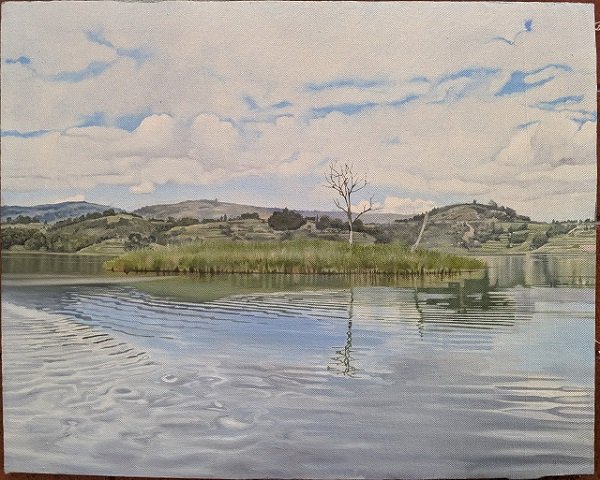
Agaba Hillary’s landscape paintings communicate more than the usual message of nature conversation through their exploration of everyday themes and figurative presentation of the natural world
ART | DOMINIC MUWANGUZI | Landscape painting refers to the depiction of the natural scenery in art. The genre has been in existence for many centuries beginning from the Ancient times where frescos created during this period of Greek and Roman empires’ supremacy, depicted rush gardens in their compositions. In the Medieval and Renaissance period, artists began to use landscapes as backgrounds to their exploration of religious and sometimes historical themes in their paintings. This is evident in the Last supper and Mona Lisa paintings by Leonardo Da Vinci created during the 14th century. Later during the 19th century, the art form gained prominence among artists as a form of imagery for peaceful and sublime settings. This era was the inspiration for other artistic movements like impressionism and post- impressionism where artists like Vincent Van Gogh explored expressive and subjective interpretations of the art form. In Contemporary art, landscape is used to explore contemporary themes of environment conservation and sustainability, and human relationship with the nature.
With a background in formal art learning and borrowing inspiration from landscape artists like George Inness, George Constable and Winslow Homer, Ugandan artist, Hillary Agaba, has made landscape painting his forte. The artist variously explores the genre with the inclusion of different elements adopted from the diverse artistic periods throughout the passage of time. His natural draughtmanship coupled with his incisive eye which facilitates him to capture as much detail from the natural sceneries and their immediate surroundings, contribute to his exceptional stylistic approach on canvas. This studio technique is further underscored by his use of oils with infuse a rich texture to his paintings, making them more than aesthetically captivating to the viewer. When standing before one of his paintings, you’re gripped with a deep sense of intimacy with the natural world. The manner in which the young artist effortlessly captures the fleeting moments of light and colour in nature is amazing and prompts you to feel closer with his subject matter and theme. This is evident in the painting The Punishment Island, where he portrays a serene and peaceful atmosphere with a foreground of a vast calm water body with an Island of rush vegetation in the middle, and sprawling cultivated hilly planes in the background. This quality is further captured in the Untitled painting depicting two women with a background of thicket which disappear into the distance and a vast form of water body that stretches as far as the eye can see. These two paintings appropriately capture the viewers’ attention and transport them onto canvas with the way they radiate with unmatched vibrancy.
The artist draws inspiration from his immediate surroundings of Kabale in Kigezi region, Western Uganda to create paintings which are reminiscent of his early childhood experience in this rural district. This conspires to themes in his work like, how human are connected to nature, changes of nature that have resulted from people’s activities and nature as an identity to specific people. In this, his paintings acquire an identity of being metaphors of everyday living and as a tool for activism. Through painting about natural vegetation and human activity within such environments, the artist incites conversations about the pertinent need to preserve and conserve nature and humanity. Conversely, this figurative representation gives his artworks an identity of a visual archive for social- cultural heritage conversation which can be appreciated by diverse audiences. In The Mudfish Catcher, the artist depicts a man in a swamp using a traditional trap to catch mudfish. This traditional technique of catching mudfish is slowly but steadily becoming extinct and is now replaced by new methods which emphasize the use of modern fishing nets. More so, the indigenous knowledge and skills of weaving such fish traps is fast being eroded because of a lack of interest by the young generation to learn such artisanal occupations. The fact that the artist paints this scene is a gesture to documenting a community’s cultural heritage which is under threat.
Agaba’s landscape paintings capturing diverse forms of the natural world are a representation of his deep relationship with nature. Through such connection, the artist is able to explore his immediate surroundings which reveal to us his past and present. Growing up in the rural country side of Kabale, this experience afforded him a deeper insight into the importance of nature to humanity not only as an environment for cultivation but as a therapeutic tool for rejuvenation and self- discovery. Therefore, besides the attribute of social- cultural heritage and nature conservation, these landscape paintings provide an escape route from the mundane nature of life and open a new window of spiritual reconstruction for all those who encounter them.





